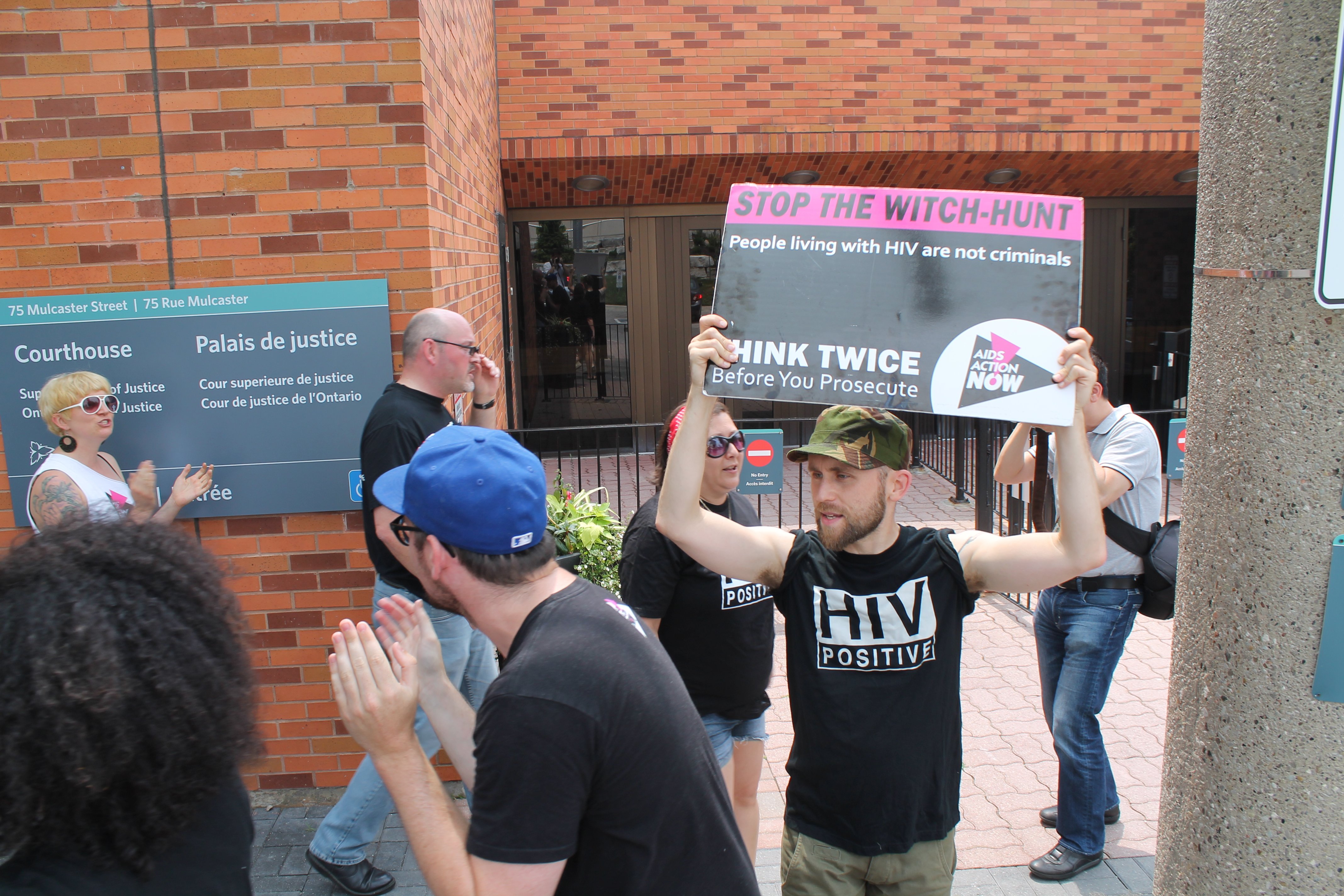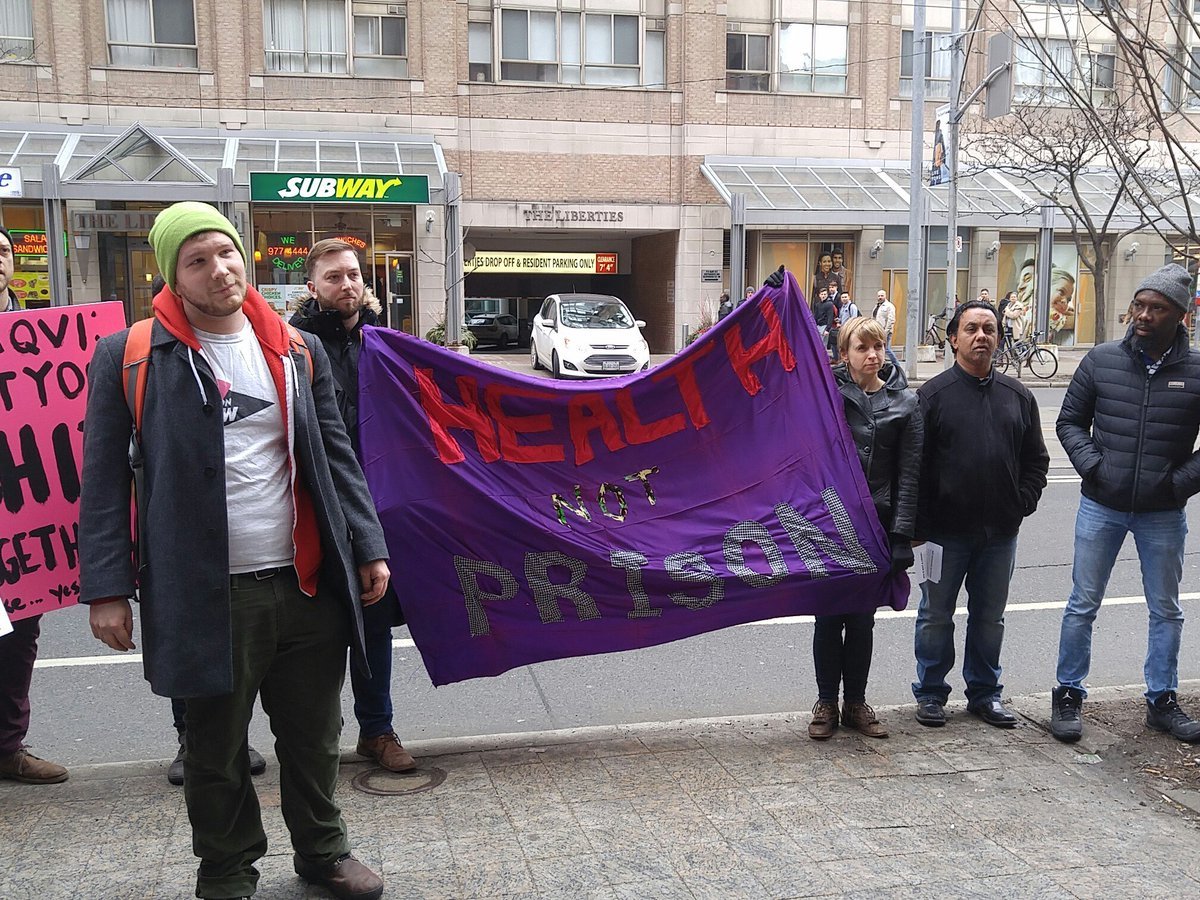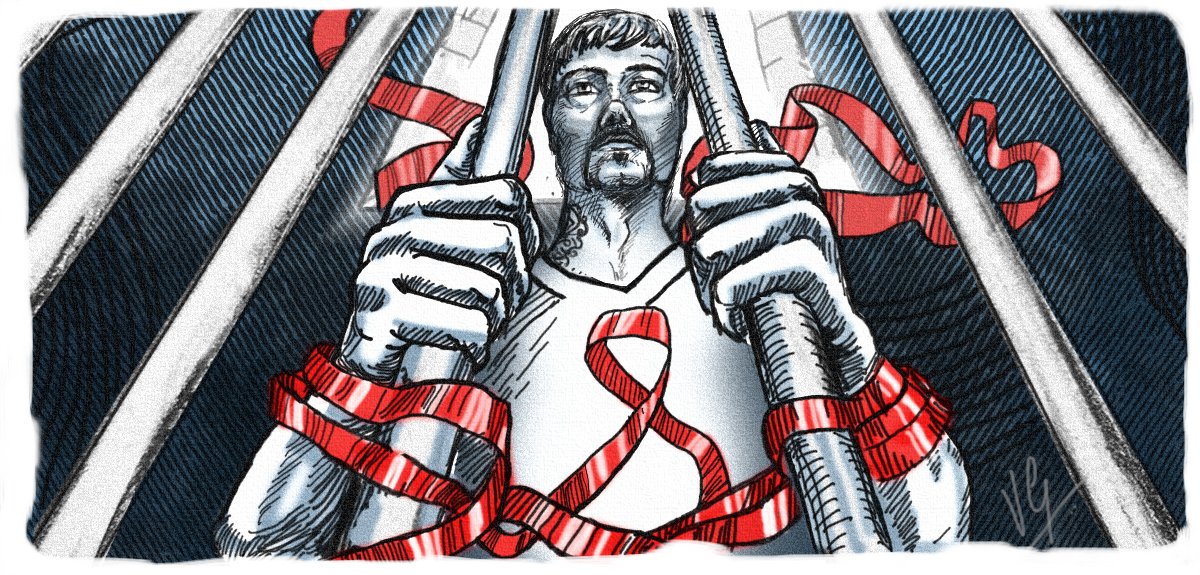This article stems from a partnership between Xtra Spark and the Canadian HIV/AIDS Legal Network, to support their call for legal reform and prosecutorial guidelines surrounding the issue of HIV criminalization. Learn more about how Xtra Spark supports activism in our communities here.
I couldn’t believe it, and yet I shouldn’t have been surprised, given what I knew.
A friend of mine had just been informed that his HIV test was confirmed positive. And in that moment, as my friend’s life changed forever, the well-meaning doctor tried awkwardly to fill the silence — with some remarks about how my friend could be criminally charged if he didn’t disclose his status to every sexual partner.
As a lawyer well-versed in this area of law, I knew why the doctor was saying that. In a decision the year before (in September 1998), the Supreme Court of Canada had confirmed that someone with HIV could be prosecuted for aggravated assault for not disclosing to a sexual partner, at least in some circumstances.
I also knew that what the doctor was saying wasn’t entirely correct because precisely which circumstances trigger a legal duty to disclose HIV were still unclear then — and the issue remains contentious to this day, nearly 20 years later.
Legal issues aside, it’s wrong to greet newly diagnosed people with a threat that they could go to jail if they don’t disclose. But my friend’s experience is not unique. Many physicians and public health nurses are quick to inform people that they must disclose and use condoms (each and every time regardless of what the actual risks of transmission might be in a given instance) — and that if they don’t, there’s the risk of possible criminal charges.
And, of course, each time police issue a press release with the name and photo of someone accused of not disclosing, every person living with HIV is reminded that they live under the shadow of possible prosecution — and accompanying trial in the court of public opinion — that could be just one allegation away.
How did we reach the point where every person living with HIV is considered a potential criminal?
The early years of the epidemic
To answer that question, we need to go back to the early years of the HIV epidemic, and consider the combination of factors that contributed to the criminalization of HIV in the first place and how these factors have shaped its evolution since.
We start in North America in the early– to mid–1980s with the basic ingredients: A frightening new, and apparently communicable, disease that progresses rapidly, most often to death, with no known effective treatment and a lack of information — even active misinformation in some quarters — about how it spreads. The resulting fear of contagion sparks an understandable human impulse to contain, to distance, and to avoid harm, whether real or simply perceived.
Add several layers of inequality and misguided morality, because the epidemic is particularly identified in marginalized populations already subject to social disapproval and state surveillance. Gay sex, blamed early on for the spread of AIDS, had only been decriminalized a few years earlier in Canada (and remained a crime in many US states), and of course gay people were still widely stigmatized across the continent. Sex workers remain heavily stigmatized, and criminalized, to this day.
Infections were also appearing among people who inject drugs, who already carried the deep stigma of addiction and were also facing a deliberately intensified “war on drugs,” a program of criminal prohibition and incarceration rooted in and reinforcing what was already a centuries-long history of racism against Black and Indigenous people in North America.
HIV therefore entered the public consciousness as a disease of perceived deviance, whether in relation to sex, drugs or both.
Now, add a handful of ostensible cases of “wilful HIV transmission” sensationalized in media reports that often reinforced the same prejudices and assumptions about sexuality, gender, race, sex work and drug use. (Consider, for example, the front page of the Halifax Chronicle Herald in late September 1988— “AIDS Fiend Strikes Again” — which kicked off its coverage of a “bisexual AIDS carrier” charged in the first Canadian criminal prosecution for HIV nondisclosure to a sexual partner.)
Front page of the Halifax Chronicle Herald, which ran an article called, “AIDS Fiend Strikes Again” on Sep. 19, 1988.
Credit: Courtesy Toronto Public Library
Finally, throw in some prosecutors and legislators acting from a variety of motives. Some are no doubt well-intentioned, acting out of a legitimate concern about trying to prevent the harm of further infection. But there are also plenty of moral entrepreneurs perfectly willing or eager to seize upon a new disease as “proof” of degeneracy, or cite a sensational media case as evidence of the need for a “tough” response to protect society.
It’s therefore no surprise that, within a few years of what was later called the human immunodeficiency virus (HIV) being identified in 1983, a new front opened up in the emerging epidemic: the resort to criminal law as a tool to respond to the perceived threat to public health.
It’s also no surprise that the same pre-existing prejudices that pushed a criminal response onto a health epidemic saw the criminal justice system quickly go overboard in applying those laws.
And that’s exactly what has played out in many countries, including Canada.
The rulings begin
Canada witnessed its first prosecution for HIV nondisclosure to a sexual partner in 1988 in the R v Wentzell case. Responding to a small but growing number of cases and with no clear legal precedent to apply, prosecutors pursued convictions using various crimes in the Criminal Code, seeing what would stick. Charges laid included “criminal negligence causing bodily harm,” being a “common nuisance” by endangering the health and safety of the public, and “administering a noxious thing” (ie. semen containing HIV). And in a handful of cases, prosecutors pursued charges for assault or sexual assault.
Many of these early prosecutions in Canada resulted in guilty pleas. The handful of cases that actually went to trial saw mixed results from different courts. But in the early 1990s, one case set the stage for the past two decades of growing HIV criminalization.
The case, R v Cuerrier, began in a BC court in 1992 and eventually reached the Supreme Court of Canada in 1998. This was the first chance for the country’s highest court to decide if not disclosing your HIV-positive status to a sexual partner might be a crime —and specifically, an assault.
The Supreme Court decided that there is no blanket duty to disclose your HIV-positive status to a sexual partner, unless you’re having sex that carries a “significant risk of serious bodily harm.” The court ruled that not revealing your HIV status in that case counts as “fraud,” which means your partner’s consent to sex isn’t legally valid, and therefore you have assaulted them. But the court failed to clearly define what counts as a “significant risk” of transmission. (It did suggest that using condoms might lower the risk enough that it wasn’t “significant,” which led to many lawyers arguing about “protected” versus “unprotected” sex in courts over the next few years.)
Guilty pleas and convictions began to accumulate more rapidly in the years following the Supreme Court decision. The charge most frequently laid has been “aggravated sexual assault,” one of the most serious offences included in the Criminal Code. (The maximum penalty upon conviction for this offence is life imprisonment, plus mandatory registration as a sex offender.)
And because the Supreme Court’s ruling required only that there be a “significant risk” of transmission — not actual transmission — a substantial majority of prosecutions and convictions in Canada to date involve allegations of exposure to HIV. In the majority of known prosecutions, HIV has not actually been transmitted.
In fact, over nearly 20 years of documented prosecutions in Canada, many prosecutions have involved zero to minimal risk of actual HIV transmission.
In 2012, a pair of appeals — one from Manitoba, the other from Quebec — brought the issue back before the Supreme Court of Canada, but the rulings were a profound disappointment. The court said there is a “significant risk of serious bodily harm” when there is a “realistic possibility” of transmitting HIV. But despite stating that it didn’t want to criminalize people in cases where there was only a small possibility of transmission, it nonetheless did so — and a number of other courts have followed suit.
The rulings have also raised more questions about what counts as a “realistic possibility” of transmission, and when a person with HIV has done enough to reduce that possibility so that they are no longer criminals if they don’t disclose their status. The Court seemed to backtrack dangerously on its earlier suggestion that using a condom might be adequate to lower the risk so that no disclosure would be required; this remains an ongoing fight in some court cases.
And to this day it remains a live issue whether someone who has a low or undetectable viral load is a criminal if they don’t disclose their status. This aspect of the law continues to evolve, given the additional scientific evidence emerging about the effectiveness of anti-HIV drugs and the reality that the risk of transmission from someone living with HIV with an undetectable viral load is effectively zero. The result is that the law is still unclear, courts are still reaching contradictory conclusions — and people living with HIV are still being prosecuted for a very serious criminal offence, for not disclosing their HIV status even where there is zero risk or an exceedingly small risk of transmission.

HIV/AIDS criminalization activists demonstrate outside a courthouse in Barrie, Ontario, in July 2013. Credit: Courtesy Canadian HIV/AIDS Legal Network
Demanding change
But people are resisting the ongoing miscarriages of justice. Human rights groups, people living with HIV, and community organizations are going to court and speaking out in the court of public opinion. We are picketing outside courthouses, and protesting in front of the attorney general’s office in Ontario. We are taking action online to send a message to politicians, and meeting with them to lobby face-to-face.
Health care providers are outlining the many ways in which the climate of fear, misinformation and stigma created by these prosecutions makes their work of preventing HIV, and encouraging HIV testing, more difficult.
Scientists are also getting involved. Dozens of leading Canadian scientific experts on HIV have issued a consensus statement on what the science tells us about the possibility of transmission through various sexual acts. They are concerned that the criminal justice system’s approach to this issue is increasingly out of step with the available science.
Women’s rights advocates and feminist legal scholars are increasingly expressing concern about how using sexual assault to prosecute allegations of HIV nondisclosure is both being driven by HIV stigma (including against women living with HIV), and also risks damaging some important, hard-won protections in sexual assault law.
And thanks to the work of advocates such as the Canadian HIV/AIDS Legal Network, on World AIDS Day 2016, Canada’s federal justice minister made a historic statement publicly recognizing the problem of over-criminalization of HIV, and committing to look at options to address it, including in discussions with provincial governments, scientific experts and communities affected.

Prime Minister Justin Trudeau and Justice Minister Jody Wilson-Raybould announce a review of Canada’s HIV laws on Parliament Hill on Dec 1, 2016. Credit: Dylan C Robertson/Xtra
For years, advocates have urged provincial attorneys general to use their clear legal authority to adopt sound guidelines for prosecutors, reflecting solid science and a concern for protecting human rights, that would limit, in practice, the cases in which charges are pursued.
Guidelines could help forestall prosecutions in cases where a condom is used, for example, or where a person living with HIV has a low or undetectable viral load, or only had oral sex — because the possibility of transmission in such cases isn’t substantial enough to warrant using the harsh, blunt tool of the criminal law. (These aren’t the only circumstances where there should be no prosecutions, just some obvious examples of what guidelines could address.)
Guidelines could also require prosecutors to ensure that scientific experts are consulted about the actual possibility of transmission, and to have to justify why a prosecution should proceed if the science doesn’t establish a substantial risk.
Guidelines could address important practical issues such as releasing people on bail pending a trial, how prosecutors should avoid contributing to media sensationalism about cases, and sentencing requests by prosecutors in the event of a conviction. This sort of measure has been taken in the United Kingdom, leading to a measurable reduction in prosecutions where they were inappropriate. It should be part of the solution to the problem of overcriminalization in Canada too.
The campaign for prosecutorial guidelines has been particularly focused on Ontario, the worst offender in Canada when it comes to overly broad prosecutions. A loose coalition of HIV organizations and people living with HIV, the Ontario Working Group on Criminal Law and HIV Exposure (of which our organization is a member), has been leading that effort, including putting forward numerous recommendations for prosecutorial guidelines in 2011.
Yet those proposals have been flatly disregarded. Successive attorneys general in Ontario have so far refused to adopt any sound guidelines for prosecutors.
But community activists continue to build pressure. And while discussions continue between the federal, provincial and territorial governments about ways to limit unjust use of the criminal law, we are calling for an immediate moratorium on prosecutions for HIV nondisclosure, except in cases where it is alleged that someone intentionally infected someone with HIV.

People gather outside the Ontario Attorney General’s office on Feb 22, 2017 to protest the lack of action from Attorney General Yasir Naqvi on implementing scientifically-sound prosecutorial guidelines for HIV offences. Credit: Arshy Mann/Xtra
Prosecutorial guidelines won’t be a panacea, but they could have a substantial impact in limiting unjust prosecutions. No doubt other measures will be needed as well. We may even need to get the federal government to change the Criminal Code to stop prosecutions for HIV nondisclosure as “sexual assault” and more narrowly define the circumstances in which there may be some criminal offence — a step that needs to be considered and done very carefully, with commitment from the federal justice minister and in consultation with community advocates and legal experts, in order to achieve this desired outcome.
It will also continue to undermine truly effective HIV prevention efforts, as federal Justice Minister Jody Wilson-Raybould publicly recognized last December. “The over-criminalization of HIV nondisclosure discourages many individuals from being tested and seeking treatment, and further stigmatizes those living with HIV or AIDS,” she said.
So join the call from the Ontario coalition for a moratorium on prosecutions and for sound prosecutorial guidelines. Add your voice to the growing demands for HIV justice by sending a message to Ontario’s Attorney General Yasir Naqvi.
Help us stop the witch-hunt.
Richard Elliott is the executive director of the Canadian HIV/AIDS Legal Network (aidslaw.ca), which works to protect and promote the human rights of people living with HIV and of communities particularly affected by the epidemic.
Editor’s note, Aug 22, 2017: An earlier version of this article described the risk of HIV transmission from someone with an undetectable viral load as nearly zero. In fact, experts agree that the risk in that case is effectively zero.


 Why you can trust Xtra
Why you can trust Xtra